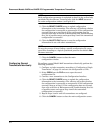
Section
3-1
3 Operation
SafetyMessages ................................page3-1
Power Supply . . . . . . . . . . . . . ......................page3-1
Configuration ...................................page3-2
IntermittentSensorAlgorithm .....................page3-5
SAFETY MESSAGES Instructions and procedures in this section may require special
precautions to ensure the safety of the personnel performing the
operations. Information that raises potential safety issues is indicated
by a warning symbol ( ). Please refer to the following safety messages
before performing an operation preceded by this symbol.
Warning
POWER SUPPLY The dc power supply should provide power with a ripple that is less
than two percent of the nominal supply voltage. The total resistance
load is the sum of the resistance of the signal leads and the lead
resistance of any controller, indicator, or related piece of equipment in
the loop. Note that the resistance of intrinsic safety barriers, if used,
must be included.
Surges/Transients The transmitter will withstand electrical transients of the energy level
usually encountered in static discharges or induced switching
transients. However, high-energy transients, such as those induced by
lightning strikes, welding, heavy electrical equipment, or switch gears,
can damage both the transmitter and the sensor.
To protect against high-energy transients, install Models 244E into a
suitable connection head with the Rosemount Model 470 Transient
Protector. The Model 470 prevents damage from transients induced by
lightning, welding, heavy electrical equipment, or switching gears.
Refer to the Model 470 Transient Protector Product Data Sheet
(document number 00813-0100-4191) for more information.
If the transmitter is installed in a measurement loop, disconnect power to the transmitter
before beginning to set up the Model 244EC Configuration Interface. If the Model 244EC
connects to a transmitter while the transmitter is powered in a measurement loop, the
Model 244EC will shunt the electrical current, possibly resulting in a dangerous situation
within the measurement loop.


















